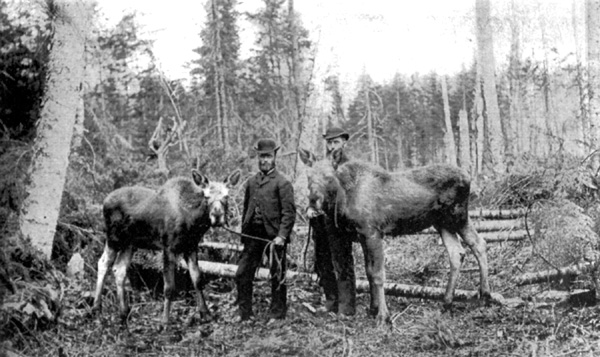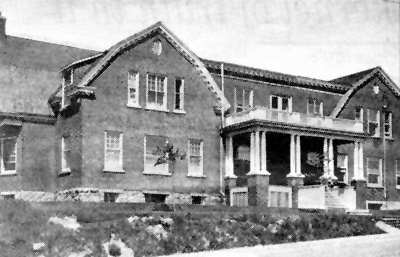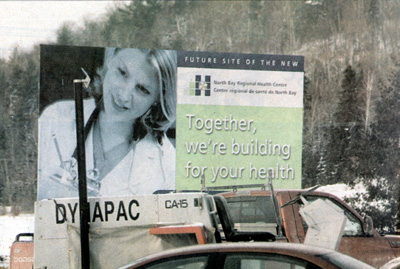 |
January 25, 2002
Taking a look at health care-then and now
|
A recent stay in the North Bay General Hospital got me comparing health
care in the past with the present. When one sees the medical advances of
today and the statistics showing the average life expectancy, it makes
one realize the incredible improvements over the last century and beyond.
In pioneer days accessibility, lack of drugs, technology and advanced surgery
made even minor problems potentially fatal.
The autobiography, Pioneering on the CPR, written by Florence Howey,
describes her early years in the 1880s when her husband was the CPR doctor
when the line was being built, and later as a doctor in Sudbury, North
Bay and Sturgeon Falls. When Dr. Howey needed help in Sudbury he brought
in Dr. McMurchy North Bay’s CPR doctor and North Bays first doctor—for
assistance. Each of the CPR employees paid 25 cents a month for medical
services, and whenever the doctor was around they lined up for a bandage,
a stitch or a bottle of something. Mrs. Howey spent hours preparing things
for her husband, who traveled miles every day and was often away overnight.
The CPR doctors also pulled teeth and did other dental tasks as required.
 |
|
| Two moose given in payment for medical services to Dr. Wm. Howey. North
Bay’s first Doctor, Dr. Archie McMurchy on right. |
|
Early doctors seldom performed most of the advanced surgery done today,
and whatever was done, was usually done on the kitchen table after a long
wait for the doctor to come by horse and buggy or sleigh. The doctor was
often not paid, or if so, with farm produce. The photo shows Dr. Howey,
mentioned above, in Sudbury with two moose given to him for medical services.
The man behind the moose is North Bay’s Dr. McMurchy who was there for
a visit.
Communities of any size began to get their own doctor in the early years
of the last century. These doctors kept office hours, but spent a significant
part of their time traveling to various locations. Dr. McMurchy also worked
for the CNR, and in one story rode a special train to Brent during the
flu epidemic in 1918 to bring some of the sick people to North Bay.
In the Powassan and Chisholm area where I live, there were several early
doctors whose names continue to be respected today long after they are
gone. The first was Dr. James Porter, followed by Dr. Harcourt, who had
been a veterinarian and qualified as a doctor. He became the MPP for Parry
Sound from 1923 to 1934. Dr. Porter’s brother Fred worked in Powassan before
he became the Medical Officer of Health for the 162nd Battalion in WWI.
Dr. Dillane, who originally came to Nipissing Village, went in to partnership
with Dr. Harcourt and served a large area. Dr. Dillane had many assistants,
including a nephew, Dr.Eric Dillane, and over the years, with the help
of various midwives, oversaw the birth of 5000 thousand babies.
As roads improved and cars became available, health care delivery became
faster and more efficient. One health care review states that "during the
first 50 years of the century we’ve seen astounding advances in the field
of medicine." The review lists the numerous advances such as vaccination,
penicillin, insulin, etc., and how diseases like smallpox, polio, diabetes,
tuberculosis, whooping cough, scarlet fever, and diphtheria were brought
under control.
The changes in the last half of the century are equally astounding.
One improvement that started early in the century was the hospital in large
centres. Wilston Steer, in his book, Boosting the Bay, talks about the
early Victorian Order of Nurses cottage hospital started in 1904 in a home-like
setting in North Bay. Nurses were trained there for other locations. St.
Joseph’s was built in 1931, and the Civic hospital at mid century with
an addition in 1968. Both hospitals were joined together in 1993 to form
the North Bay General Hospital.
 |
Queen Victoria Hospital was an early hospital in North bay |
The North Bay General has a $60 million budget, 218 beds and 115 medical
staff, including many specialists. It boasts a million dollar CAT scan,
which has been invaluable in diagnosis work.
By 2005 the state of the art North Bay Regional Health Care Centre will
be completed, and will include the Northeastern Ontario Mental Health Centre,
which will replace the old Psychiatric Hospital. All of this will be centered
on 14 acres at highway 17 and Gormanville Road at a cost of $225 million.
The bulldozers and back hoes are already clearing the land so the building
can start. Health care has improved elsewhere as well, for example, West
Nipissing recently opened a $3 million medical clinic.
 |
Equipment preparing the site for construction of the North
Bay Regional Health Care Centre at Gormanville Rd. and Hwy. 17. |
In my ten days in the hospital, beginning with a trip to emergency,
I was impressed by he effectiveness and quality of the service. The triage
system in emergency got me looked at quickly and I got my operation soon
thereafter. My family doctor was involved very early and visited me several
times. I was most impressed with the dedicated nurses on the 5th floor
west, working 24 hours a day to keep patients comfortable. The Patient’s
Bill of Rights, which states that the patient will be respected, informed
and involved was, in my opinion, well fulfilled. There are some problems
in the system, mostly due to costs, but all things considered—and certainly
compared to the past—we are well served in the area.
Heritage Perspective Home Page
|

![]() Past
Forward is now on Facebook "LIKE" us to keep in touch
Past
Forward is now on Facebook "LIKE" us to keep in touch